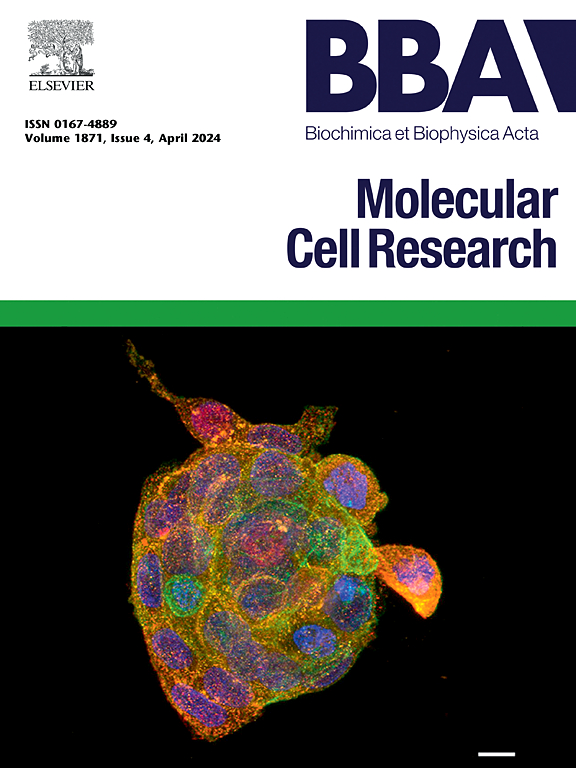S100A16敲低可降低RPN2表达,抑制β-catenin/TCF信号,抑制宫颈癌细胞转移
IF 3.7
2区 生物学
Q1 BIOCHEMISTRY & MOLECULAR BIOLOGY
Biochimica et biophysica acta. Molecular cell research
Pub Date : 2025-09-02
DOI:10.1016/j.bbamcr.2025.120053
引用次数: 0
摘要
S100钙结合蛋白A16 (S100A16)是最近发现的S100钙结合蛋白家族成员,与多种癌症有关。然而,它在宫颈癌中的具体作用尚不清楚。在本研究中,我们证明沉默S100A16基因可以抑制HeLa和SiHa细胞的迁移能力,而不影响其生存能力。RNA测序分析显示,S100A16显著调控核糖磷酸化蛋白II (ribophorin II, RPN2)。此外,单独敲低RPN2可有效抑制细胞迁移,过表达S100A16可逆转RPN2沉默导致的细胞迁移抑制。机制上,S100A16通过磷酸化的信号转导和转录激活因子3 (p-STAT3)调节RPN2,而RPN2又通过磷酸化的GSK3β调节下游的β-catenin/TCF通路。细胞核和细胞质蛋白的分析进一步表明,S100A16沉默降低了β-catenin转运到细胞核的能力。综上所述,我们的研究发现S100A16沉默通过p-STAT3下调RPN2水平,从而抑制p-GSK3β/β-catenin/TCF信号通路。这些发现强调S100A16是宫颈癌的潜在治疗靶点。本文章由计算机程序翻译,如有差异,请以英文原文为准。
S100A16 knockdown reduces RPN2 expression and inhibits β-catenin/TCF signaling, leading to suppressed metastasis in cervical cancer cells
S100 calcium-binding protein A16 (S100A16), the most recently identified member of the S100 calcium-binding protein family, has been implicated in various cancers. However, its specific role in cervical cancer remains unclear. In this study, we demonstrated that silencing the S100A16 gene inhibits the migratory ability of HeLa and SiHa cells without affecting their viability. RNA sequencing analysis revealed that S100A16 significantly regulates ribophorin II (RPN2). Furthermore, RPN2 knockdown alone effectively suppressed cell migration and overexpression of S100A16 reversed the inhibition of migration caused by RPN2 silencing. Mechanistically, S100A16 was observed to regulate RPN2 through phosphorylated signal transducer and activator of transcription 3 (p-STAT3), which, in turn, modulated the downstream β-catenin/TCF pathway via phosphorylated GSK3β. An analysis of nuclear and cytosolic protein fractions further indicated that S100A16 silencing reduces the ability of β-catenin to translocate into the nucleus. In conclusion, our research revealed that S100A16 silencing downregulated RPN2 levels through p-STAT3, thereby inhibiting the p-GSK3β/β-catenin/TCF signaling pathway. These findings highlight S100A16 as a potential therapeutic target for cervical cancer.
求助全文
通过发布文献求助,成功后即可免费获取论文全文。
去求助
来源期刊
CiteScore
10.00
自引率
2.00%
发文量
151
审稿时长
44 days
期刊介绍:
BBA Molecular Cell Research focuses on understanding the mechanisms of cellular processes at the molecular level. These include aspects of cellular signaling, signal transduction, cell cycle, apoptosis, intracellular trafficking, secretory and endocytic pathways, biogenesis of cell organelles, cytoskeletal structures, cellular interactions, cell/tissue differentiation and cellular enzymology. Also included are studies at the interface between Cell Biology and Biophysics which apply for example novel imaging methods for characterizing cellular processes.

 求助内容:
求助内容: 应助结果提醒方式:
应助结果提醒方式:


